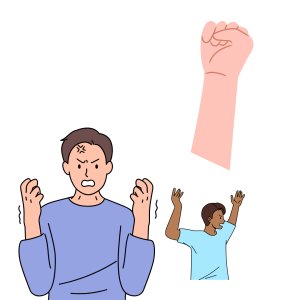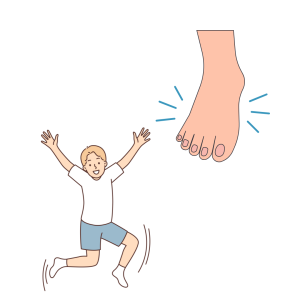Nervous System & Mental Health
By body part

Throat:
Your vagus nerve runs through both the larynx and pharynx in your throat, humming creates a vibration that stimulates your vagus nerve and can increase your vagal tone. When you hum, you induce parasympathetic dominance, which means you move out of “fight or flight” stress mode into relaxation.
Humming…
- Reduces our levels of stress
- Lowers blood pressure and heart rate
- Makes our exhale longer than our inhale, helping us to relax.
- Improves air flow between the sinuses and the nasal cavity so we breathe better.
- Increases Nitric oxide (NO), a neural transmitter that helps sterilize the air you breathe and protect your body by sterilizing airborne pathogens. It also increases oxygen to your heart arteries and reduces blood pressure.
Somatic Videos:
- Finding Your Groove– Activating
Using music to access rhythm and your physical sense of yourself through dance

Lungs:
When we feel stressed, our breathing rate and pattern changes as part of the ‘fight-or-flight response’. While sharp and frequent inhales have an activating effect — meaning they’ll keep the body in “go” mode — exhales calm the body, triggering a “rest and digest” state. In times of high stress, concentrating on breathing out can help the body relax.
Breathing…
- Brings more oxygen into your blood to clear out stress chemicals.
- Lowers blood pressure and heart rate
- Makes our exhale longer than our inhale, helping us to relax.
- Reduces lactic acid build-up in muscle tissue from the tension we create when we’re stressed.
- Calmly during the fight, flight, or freeze responses can play a huge role in how long panic lasts because the body sends messages to the brain through the rate and quality of breath.
Somatic Videos:
- Conscious Breathing– Calming
Reconnecting to the baseline experience of inhale and exhale and how it serves us - Three Dimensional Breathing– Calming
Accessing fuller, more effective use of breath and the structures that support our breathing - Releasing & Activating through Effort– Activating
Using effortful breath and movement qualities to wake up the senses and release any tension or stress that is being held within the body

Hands:
Our hands connect to our brain and we can use them to train the self-control muscle in the brain. Squeezing, pushing and pulling helps the finish fight responses, which helps the brain think clearly after frustration.
Our hands can help…
- Reduce our levels of stress and helps us concentrate
- Calm down the automatic stress that our body sends to our hands through squeezing
- Improve our self control and will power while helping us feel in charge of ourselves
- Us feel grounded because pushing helps the body feel gravity and weight.
- Reaching and Pulling help the mind gain outer attention because our muscles and joints reach out, focus on balancing against gravity, and bring the force pushed out back to us.
Somatic Videos:
- Tactile Activation– Calming
Reinvigorating and grounding in the body through self-to-self physical contact - Mobilizing the Upper Body– Activating
Freeing up the muscles and joints of the back, ribcage, neck, shoulders, and arms through a simple mobilizing exercise - Releasing & Activating through Effort– Activating
Using effortful breath and movement qualities to wake up the senses and release any tension or stress that is being held within the body

Stomach:
Our stomach is an important indicator of stress and negative emotions in the body because we begin to eat unconsciously or uncontrollably, and at times stop eating altogether.
Emotional eating…
- From extreme stress can make our body not want food, so we skip a meal or avoid food for longer than healthy.
- Can mean that stress is causing our body to store more fat than when relaxed because of the chemical cortisol.
- From higher cortisol levels may lead to anxiety-related weight gain and cause obesity-associated metabolic disturbances.
- Happens the most after being frustrated or angry.
- Can lower our body's ability to break down glucose, lower our energy levels and increase our appetite for sweet, salty or fatty foods.
Somatic Videos:
- Body Scan– Calming
Finding present awareness within the body by attending to physical sensations and needs - Moving Our Weight– Activating
Organizing, coordinating, and reconnecting all of the parts of the body through simple weight shifts to bring yourself back to center

Feet:
During a stress response, everything in your body is prepared to run, but we usually sit, which can start counterproductive thinking and a toxic backlog of stress energy in our nervous system. Short bursts of exercise like jumping or doing jumping jacks can help move that excess energy out of the body by triggering the rest-and-digest response.
Jumping can help…
- Reduce our levels of stress and increase indorphins
- Our blood circulation through active movement in our calves muscles.
- The mind gain inner attention because our muscles, tissue and joints are contracting and compressing on our command.
- Us feel grounded because the body feels gravity and weight.
- Decrease cortisol levels, depression and anxiety by increasing serotonin and dopamine levels in the brain (the happiness and good mood chemicals).
Somatic Videos:
- Pandiculation for Feet – Gentle contractions into tightness and slow releases of the contracted muscles in the feet.
- Basic Calf Pandiculation for Tight Calves– Basic Calf Pandiculation Sequence for Tight Calves, Underside Foot Pain, Plantar Fasciitis, Runners feet and other foot tension.
- Releasing & Activating through Effort– Activating
Using effortful breath and movement qualities to wake up the senses and release any tension or stress that is being held within the body

Bilateral Movements:
Bilateral movements like looking in opposite directions, using opposite hands, or tapping in opposite sides of the body allows the autonomic nervous system, or parasympathetic system, to induce the relaxation response because it simultaneously activates the areas in our brain responsible for emotional processing and higher-level thought functions.
Crossing our body’s midline can help…
- Process memory better, process old trauma and induce a relaxation response.
- Increase levels of certain neurotransmitters in the brain, like serotonin and dopamine, which are associated with feelings of well-being and happiness.
- Help both sides of the brain to communicate well and share information.
- Help the nervous system calm down so the trauma or stress can actually be processed. (e.g. Butterfly hugs)
- Strengthen the neural connections between the two hemispheres of the brain. This enhanced connectivity is important for various cognitive functions, including problem-solving, reading, writing, and math skills.
Somatic Videos:
- Releasing Weight through Ideokinesis– Calming
Using imagery to facilitate a shift in the way we sense and release the physical and emotional weight that we carry - Shoulder & Neck Tension Release– Calming
A simple exercise, rooted in the Feldenkrais Method, to quickly and easily release shoulder and neck tension and give your posture a reset - Mobilizing the Upper Body– Activating
Freeing up the muscles and joints of the back, ribcage, neck, shoulders, and arms through a simple mobilizing exercise - Posterior Chain Stretch– Calming and Activating
Waking up, lengthening, and soothing the spine, pelvis, and muscles that run the length of the back of the body
